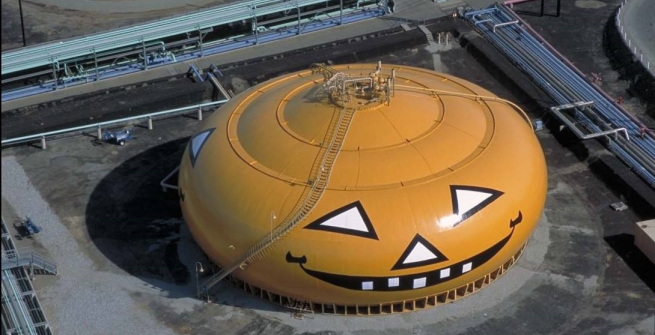Just before the Harbor Freeway ends and spits you into San Pedro, a large orange-colored object within the foothills leading to Palos Verdes usually catches your eye. Even on a foggy day, it stands out among a wall of squat white cylinders and brown earth surrounding it. The jarring color and shape inevitably provoke a “what is that?” for anyone seeing it for the first time. Anyone living or working in the South Bay can answer that question without missing a beat but, for me, it took nearly three months of making this commute before I finally asked one of the locals, what is that, anyway? My question was prompted by the fact that the orange object had suddenly grown a face that was staring right back at me.
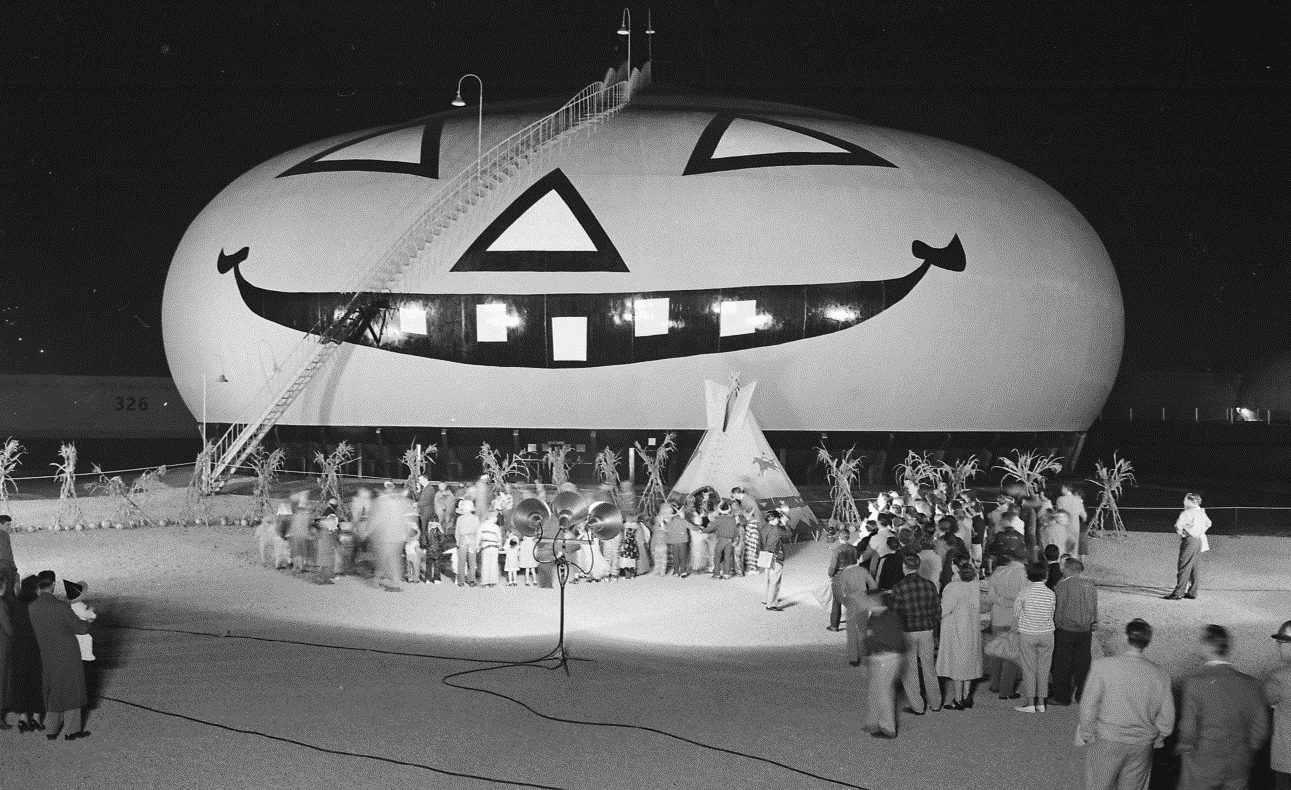
The face in question, I soon learned, belongs to a South Bay touchstone known as Smilin’ Jack. No, Smilin’ Jack obviously isn’t the world’s largest pumpkin, he’s a hortensphere, a squat oval tank used to store natural gasoline at the Phillips 66 refinery (formerly Union Oil) in Wilmington. The tank and others like it are used for “storing gasses that will not remain in liquid form unless held under slight pressure or for light oils that vaporize readily.” A hortensphere owes its “noded spheroid” shape to the fact that squat tanks are able to withstand a greater amount of pressure than a tank with a cylindrical shape. At the refinery, Jack was known as hortensphere 304 and, reportedly, has a capacity of approximately 3.3 million gallons. A 1968 profile from a Long Beach newspaper indicated that the hortensphere had completed construction in October 1952 and the primer used to prep the tank for a coat of paint had an orange tint. The proximity to Halloween as well as the shape and initial color of the tank’s primer drew inevitable comparisons to a pumpkin by Union Oil staff. Somewhere along the line, an employee with a rather wicked sense of humor decided the tank might as well have a jack-o’-lantern face too and their boss liked the idea.
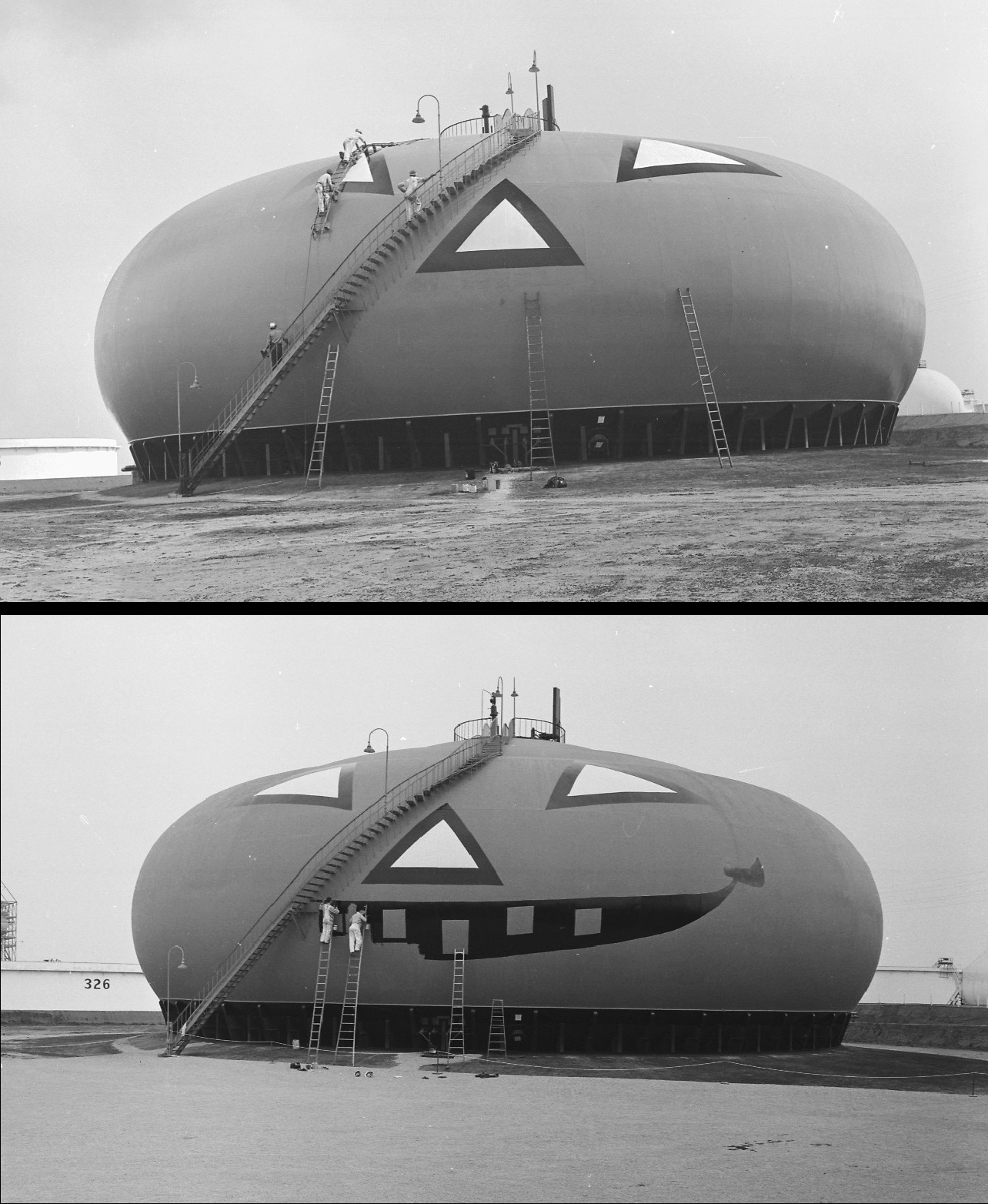
Jack’s conception is fuzzy but an October 1952 article in the Wilmington Daily Press Journal indicated that he was the “brainstorm” of an unnamed plant executive. The executive decided that temporarily painting 304 completely orange and adding a jack-o’-lantern face would be a pleasant surprise for the surrounding community on their daily commute. The suggestion eventually went all the way up to Union Oil President Reese Taylor who approved the suggestion. While the individual who came up with the idea to paint a face on the hortensphere has never been publicly identified, it may have been executive Paul Doyle, a resident of Rolling Hills Estates. Doyle was the only person from the refinery that spoke to the San Pedro News Pilot in 1952 when Smilin’ Jack debuted. News Pilot photographer Herb Phillips quoted a gleeful Doyle who remarked “that looks just like the pumpkin I carved out for my children last night!” Maybe not so coincidentally, the San Pedro News Pilot reported that “originally the pumpkin faced only the Rolling Hills, but when the Harbor Freeway was completed, the painters moved the face so it could be seen by southbound motorists.” This change, however, was not appreciated by Rolling Hills residents who, by 1964 had become accustomed to Jack’s grin: “the refinery began receiving complaining letters and phone calls from Rolling Hills.” Consequently, a second face was painted that looked towards the hills in order to make everyone happy. After Halloween, Smilin’ Jack went into hibernation when the tank was re-painted white, a task that has ceased in recent years leaving jack with an orange color year-round.
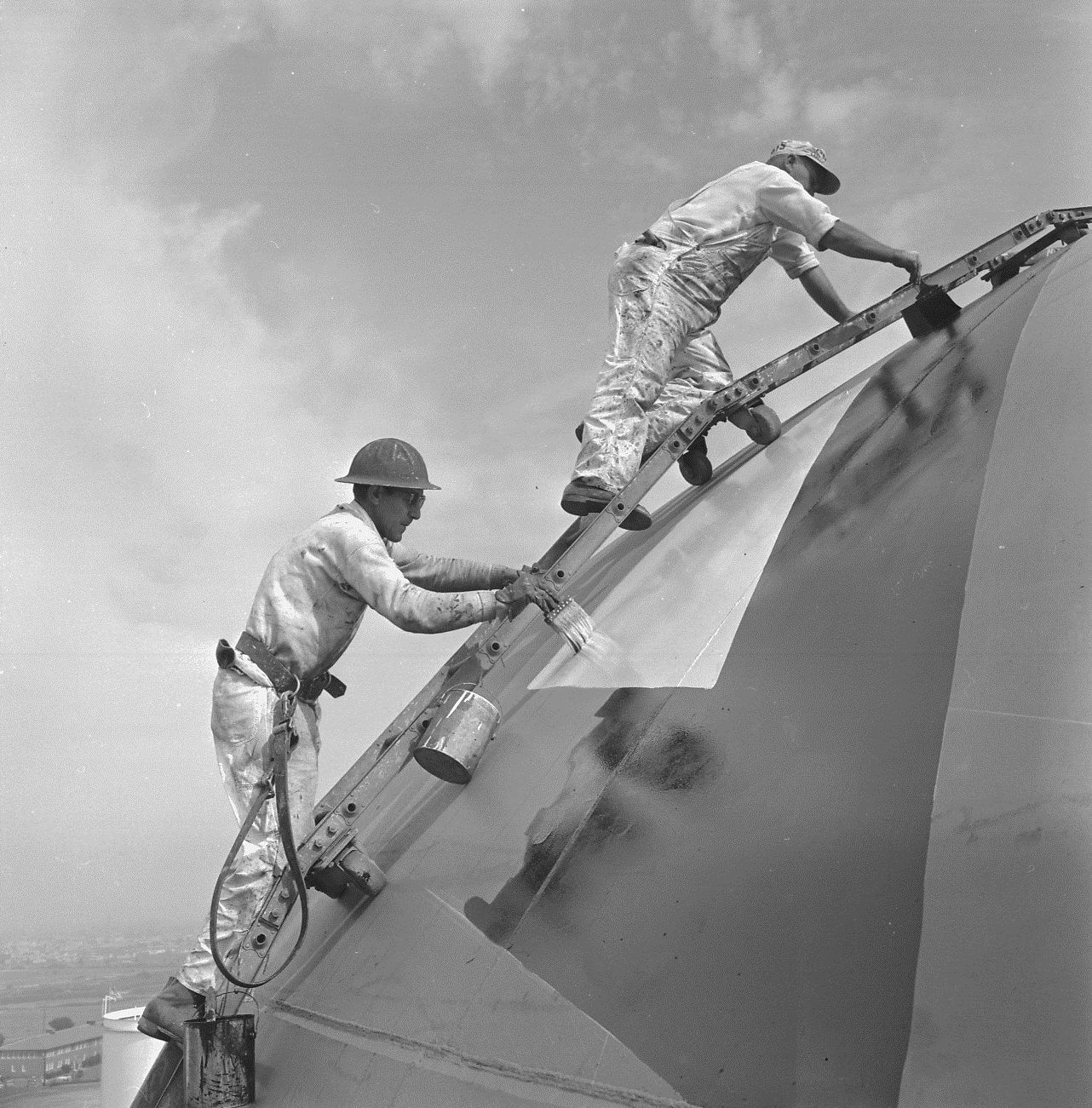
Painting Smilin’ Jack every year has been a herculean effort that has become more streamlined throughout the years. Throughout the decades, the number of gallons needed to bring Jack to life has changed as the process has become more familiar. In 1956, it was reported to have taken 180 gallons of paint to make Jack a perfect shade of pumpkin orange (plus a black 65-foot grin, six-foot tall eyes, and a nose). By 1997 the numbers were reported to be down to 113 gallons (100 gallons of orange paint, 10 gallons of black, and three gallons of white paint) to create a 73-foot mouth, 18-foot tall eyes, and a four-foot nose. The man responsible for supervising painting Jack’s face on the tank that first year was identified as Compton resident Francis Okerstrom, a worker at the plant. By 1956, local contractor Darrell Stuart had taken over painting Jack’s face. Stuart’s eponymous business had been Union Oil’s go-to contractor for most of the company’s local painting needs around the southland. In the September 24 issue of Life Magazine, Stuart was profiled as part of a series of advertisements Union Oil had taken out focusing on employees making a difference and community partnerships that the company had established. Jack’s toothy grin was a welcome cameo within the piece on Stuart and an acknowledgment of what was becoming an established tradition. Since the 1950s, a number of men have been charged with painting Jack’s face, most of whom have gone unrecognized but have done so with a full comprehension of the role that this tank plays in strengthening relations within the South Bay community. It’s not an understatement to conclude that what started out as a lark to make locals smile evolved into an annual tradition that solidified community relations.

During the fall season, Jack has been an ambassador of sorts between the refinery and the larger community. It's not totally clear when Union Oil began inviting the community at large to the grounds of the refinery but the first report of visitors happened in 1954. On October 27, 1954, the Los Angeles Times relayed that 25 children, all children of plant employees, were invited to a small lighting ceremony (in costume, of course) where Halloween treats were provided by Union Oil. In November 1955, the San Pedro News Pilot published the following message from the sixth-grade class at Channel Heights School: “The boys and girls of Channel Heights School would like to tell you that we all like the big jack-o’-lantern that is fixed for boys and girls in the harbor area. We all like it very much. I hope they will put it up again next year. Thank you.” Just so there would be no confusion, the News Pilot clarified that “the boys and girls undoubtedly are referring to Union Oil Co’s huge pumpkin-shaped tank…” In 1955, the Los Angeles Times profiled Jack in their weekend magazine, The Week, which sparked intense curiosity from Angelenos while Life Magazine ran a two-page spread on Jack that gave him national exposure. By the end of the 1950s, families across the South Bay were driving by the refinery at night just to see Jack lit up by spotlights provided by the refinery. At some point between 1956 and 1964, public spectators were invited to see Jack up close. Children typically arrive in costume and treats (traditionally caramel corn) have been given out to all who visit. The first known public invite appeared in 1964 and was published in both the Los Angeles Times and the Los Angeles Herald-Examiner. By the time Long Beach Independent columnist Ann Howe visited the refinery in 1967 with her kids in tow, visiting Jack had become a local tradition. Howe relayed that she was “most pleased and surprised” to make the visit and shared that “Union Oil not only offered off-street parking but also gave young and oldsters a bag of caramel corn…”

By the latter half of the 1960s, Smilin’ Jack’s publicity went into overdrive. He continued to gain notoriety as invites continued to pepper local newspapers and news magazines like the Long Beach Independent’s Southland where Jack made the cover of the October 27, 1968 issue. In that particular profile, Jack was deemed as the only “Jack-o’-lantern fit for a Queen,” which, of course, was an allusion to the RMS Queen Mary who had just become a Long Beach resident the previous year. By the time the 1960s ended, Smilin’ Jack had become a Los Angeles tradition with the Long Beach Press-Telegram reporting by 2017 that Jack receives approximately 20,000 visitors per year.

Union Oil, the Local Economy and Community Relations

Even before the Union Oil refinery opened in Wilmington more than a century ago, it was recognized as an important part of the South Bay’s economy. Union Oil had been founded in 1890 in Santa Paula before it relocated its headquarters to Los Angeles in 1901. As the City of Los Angeles began developing the port at San Pedro starting in 1907, it was inevitable that big businesses (particularly lumber and oil) would gravitate toward the South Bay including Union Oil. The Los Angeles Harbor Department’s 1915/1916 Annual Report announced that Union Oil Company had recently purchased a 200-acre site “immediately adjacent to tidewater,” and was in the process of building a $2 million refinery, the product of which would be exported through the Port of Los Angeles.” News that a significant portion of McDonald Ranch just north of San Pedro had been sold to Union Oil in November 1916, stirred some confusion (and jealousy, for that matter) from San Pedrans who were under the impression that the refinery would be located near the Miner fill in San Pedro. The change had “caused considerable surprise in San Pedro” but, as the Daily Pilot explained, "there isn’t land enough in the Outer Harbor for an enterprise of such magnitude."

Location was important because it was understood that a refinery would mean commercial development, civic infrastructure, and financial support for whatever neighborhood housed the plant. San Pedro, recently annexed by the City of Los Angeles, had already made significant strides in developing land along the inner channel. The completion of the Municipal Dock and Warehouse One in 1915 meant that San Pedro was leading the charge in maritime commerce while Wilmington’s shoreline was still largely marshland. The Union Oil refinery secured Wilmington’s foothold within the Port’s fledgling development and helped guarantee jobs for locals. Since that time, the plant has employed thousands of Angelenos, meaning that the refinery is not only within the community but it is an integral part of it. Smilin’ Jack was an opportunity for Union Oil to acknowledge that community and their children and this was done with the utmost respect. This sentiment was expressed directly in a series of ads entitled “Community relations (like corporate growth) is no small thing to Union Oil.” The color ads featured Jack with the following caption:
“For 358 nights of the year, the Great Pumpkin is an impostor. During all that time he assumes the identity of an 80,000-barrel spherical storage tank in the Union Oil Company’s south Los Angeles storage facility. But for the seven nights preceding Halloween, the Great Pumpkin shows his true colors. And they’re bright orange. We paint him that way with 40 gallons of paint. We paint his eyes, his nose, and his 73-foot wide toothy grin. We put lights all around him so that people can see him from a great distance. Especially little people.
When he’s ready we invite the entire community up to see him. Many people do come. Mostly, though the Great Pumpkin is a friendly face in the night to countless thousands of our neighbors. They know he’ll be gone soon after Halloween, but he’ll be back next year - just as he has for 16 years. People depend on that. And on him.
The Great Pumpkin is, first and foremost, a community relations effort. We make a policy of such efforts. We landscape our refineries to fit in, not stand apart…Our reason is this: we owe the community a never-ending debt of good neighbor responsibility. Because it is our neighbors in the community who are responsible for the growth and success of the Union Oil Company.”

Over the years locals have grown protective of Smilin’ Jack and are proud of the fact that he belongs to Wilmington. To illustrate, in 2014, The Port of Los Angeles made an ill-informed Facebook post that suggested Jack resided within San Pedro. Wilmingtonians were justifiably up in arms; one user posted that Jack was “WILMINGTON PUMPKIN, BORN AND RAISED...CHECK IT'S ADDRESS!” Another user posted that “That's not in San Pedro!!! Recognize the true city it's in —>WILMINGTON<—” A third user posted “Wilmington boundaries. Clear as day” and posted a corresponding map that outlined Jack within Wilmington’s boundaries. The Port of Los Angeles was quick to post the following addendum to their post: “Correction: the pumpkin is in Wilmington, not San Pedro.” Among these Indignant calls for accuracy, was an array of nostalgia from South Bay residents who expressed nothing but fondness for Jack:
It's been a tradition for me and my family to visit every Halloween since 1997
My dad worked for Union Oil at this very tank yard in'63! This pumpkin brings back great family memories! Thanks for sharing!!!
I used to take my kids, back in the day's, now my Grandkids, beautiful memories!!!
Loved seeing it as a kid
A good reminder of my childhood!!!
Wonderful memories of our family
childhood memories.
I loved Mr Pumpkin when I was small.
Drove by The Great Pumpkin the other day. Such a lovely childhood memory!
Growing up I remember the great pumpkin. I always associated it will Charlie Brown comic strip
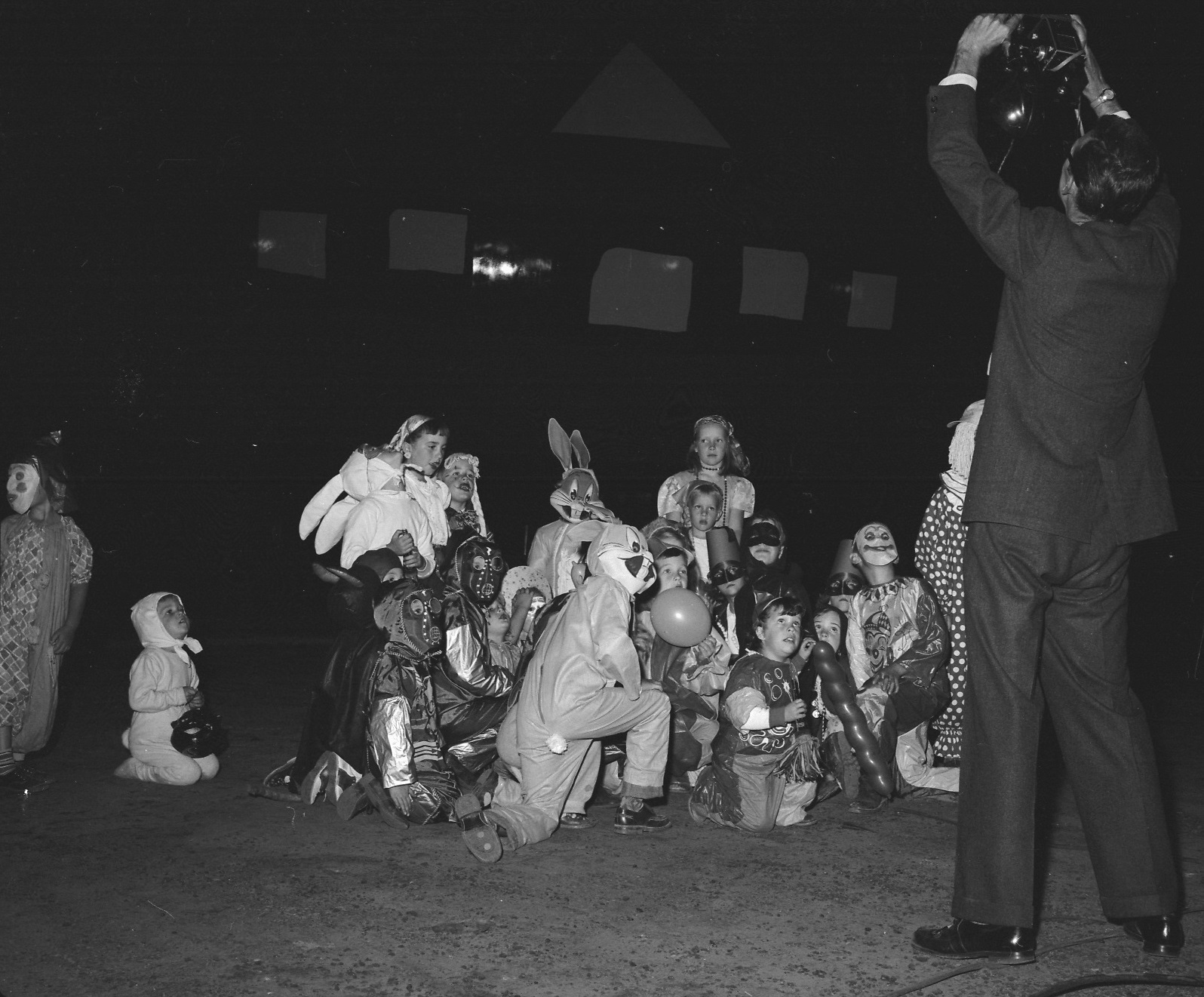
It’s Smilin’ Jack, Charlie Brown

As the last comment relayed, it’s hard to look at Jack and not have the desire to make some sort of remark about or a connection to the “Great Pumpkin” of Peanuts comic strip fame. It should be noted, however, that Smilin’ Jack debuted nearly seven years before Linus Van Peltz’s “Great Pumpkin” appeared in Charles Schultz’s comic strip. The popularity of the comic strip proved advantageous to Union Oil who made sly “wink-wink” references to a “great pumpkin” in their advertising. In fact, the first official public invite from 1964 that appeared in both the Times and the Herald-Examiner, gave a veiled nod to Schultz’s cartoon: “...regardless of the rumors circulating in certain comic strip circles, a Great Pumpkin does exist! You’ll find him at Anaheim Street in Wilmington.” The popularity of the comic strip ensured that a lot of people had heard of the Great Pumpkin, a Santa Claus-like figure who grants wishes to obedient children, but it wasn’t part of the lexicon the way it is today. In 1966 the animated film, “It’s the Great Pumpkin, Charlie Brown” aired and began what became an annual tradition that embedded the notion of a ‘great pumpkin’ in pop culture and Union Oil ran with it, at least for a while. Newspaper ads that followed the initial airing of the cartoon invited Angelenos to “pay your respects to the Great Pumpkin this Halloween!” though any mention of a comic strip was dropped. Union Oil eventually let the novelty of the Great Pumpkin moniker wear off altogether, but it's almost impossible to escape descriptions of Smilin’ Jack as “the” Great Pumpkin or simply “a great pumpkin.” A 1995 Los Angeles Times article, for example, was entitled “A Great Pumpkin with a Message” while a 2013 blog from the Port of Los Angeles described Jack as the “Harbor Community’s own Great Pumpkin.” In 2014, one Facebook user posted a photo of Jack with the following caption, “...It ‘does’ make quite a striking statement; and, takes up, a lot of territory. It's the Great Pumpkin, Charley [sic] Brown.”
The Spirit of 76: The end of an Era and Jack’s Saving Grace
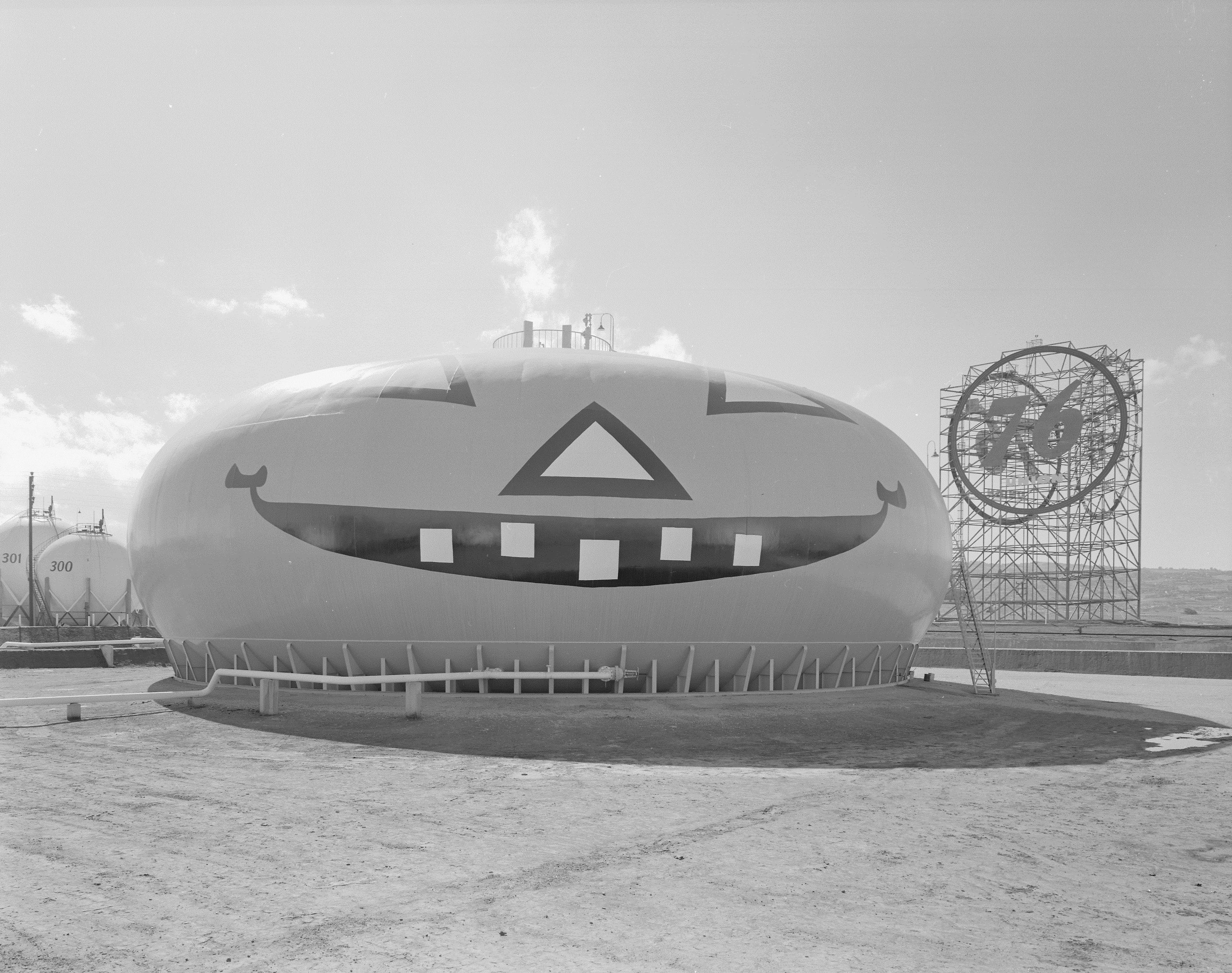
Ever since Union Oil of California and its holding company, The Unocal Corporation introduced the “Union 76” brand to their service stations, the 76 logo became a ubiquitous presence within L.A.’s auto culture. Angelenos could count on a 76 station on every street corner to fill up their gas tanks while, beginning in 1967, styrofoam “76” balls capped nearly every antenna that had filled up at a Union 76 station. As for Jack, in the 1970s, he was paired with a large neon “76” sign that kept him company and made his affiliation with the company unmistakable. Smilin’ Jack then lived through the aqua-net haze of the 1980s and the grungy flannel shirts of the 1990s but a change came in the 2000s that, frankly, could have spelled the end of him.
In 2005, Unocal was sold and effectively ceased operations. Through a series of takeovers, buyouts, and mergers, the 76 brands that Unocal created eventually landed in the care and management of Phillips 66, an energy company with a history as equally storied as Union Oils. Phillips 66 now manages the refinery where Jack lives and they have continued to maintain hortensphere 304 as the harbor community’s Halloween centerpiece. Like Union Oil before it, the Phillips 66 plant employs locals who find pride within their community and keep community traditions alive. In recent years, Phillips 66 has utilized Jack in some particularly clever ways that not only celebrate Los Angeles culture but manage to demonstrate social responsibility.
If ever there was a time to pause the festivities surrounding Jack, it would have been in 2020 during the height of the Covid-19 pandemic but, rather than impede the community’s annual tradition, Phillips 66 found a way to keep it going. In a statement from Juliana Moreno, Phillips 66’s Public Affairs & Community Relations Advisor, Phillips 66 shared that some changes would be in effect for 2020 that would allow the community to make their annual pilgrimage to Jack: "Phillips 66 is a proud member of this community, and it is important for us to provide families in the area a way to enjoy Halloween and continue on safely with this tradition. We're asking everyone to mask up this year—even Jack." Phillips 66 added a “76” logo mask to cover Jack’s smile as a nod to safety in the ongoing pandemic and also turned the visit into a drive-through event to ensure public safety. Visitors stayed in their vehicles, circling Jack, and were provided with caramel corn from masked employees through car windows.
More recently, Jack has been seen sporting a Dodgers logo. One might assume this has something to do with simply supporting the home team or celebrating their most recent World Series win but it’s actually grounded in a partnership Phillips 66 made with the Dodgers Foundation. Phillips 66 donated $35,000 to the Foundation’s efforts to increase STEM (Science, Technology, Engineering, and Mathematics) programs within local schools. In a press release, the Foundation stated that “LADF has also teamed up with the Phillips 66 Los Angeles Refinery and 76 gas stations to give the iconic Smilin’ Jack a Dodgers spin this year. In addition to his jack-o’-lantern smile, the 3-million-gallon storage tank will sport LADF decals and one additional tank will don a Dodger jersey to show their support for their favorite team.” Angelenos are happy to see that Smilin’ Jack is in good hands and that Phillips 66 not only maintains its role within the community but they appreciate what he means to the community as well.
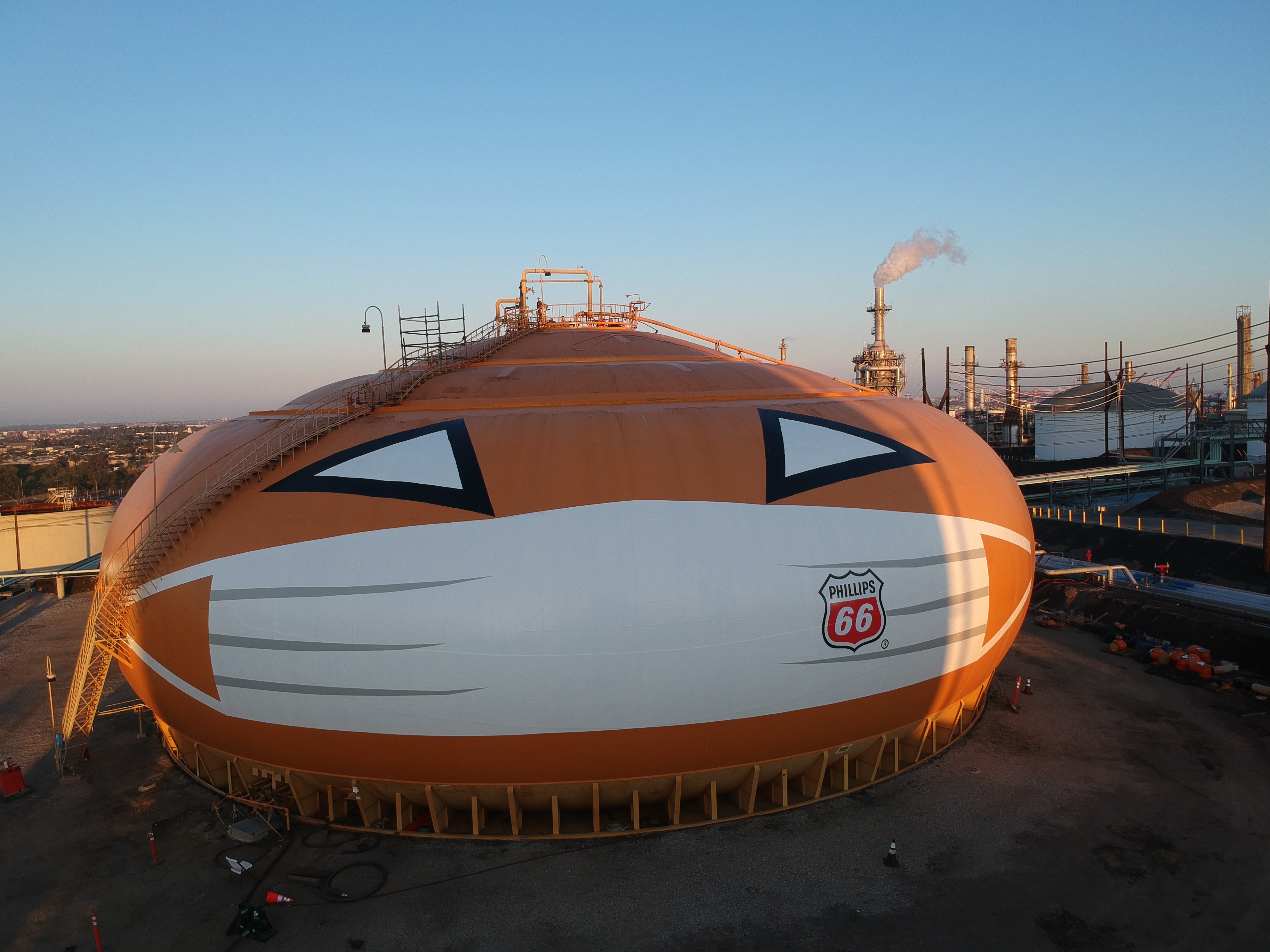
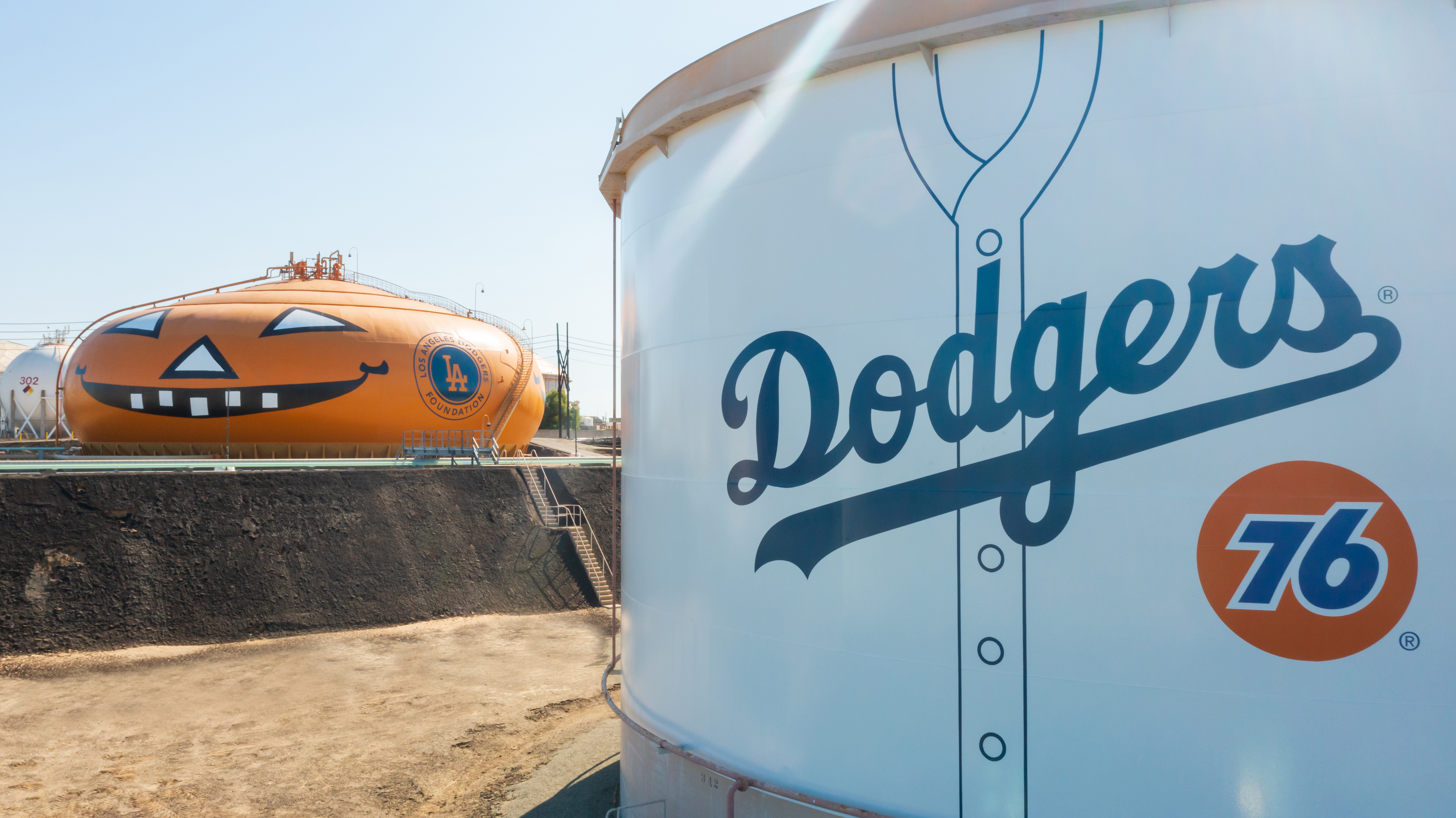
For whatever reason, Smilin’ Jack has never really been on that very exclusive list of Los Angeles landmarks that include the Hollywood Sign, the Griffith Park Observatory, and the Bradbury Building but, like those hallowed monuments, Jack has survived a very long time in a city infamous for undermining its own history. At 70, Jack has more than earned his place within that pantheon, and, for folks in the South Bay, it wouldn’t be Halloween without a massive grinning jack-o’-lantern perched on the top of the hill.
Happy 70th Birthday, Smilin’ Jack!
